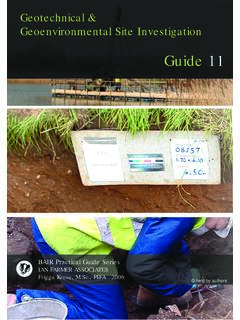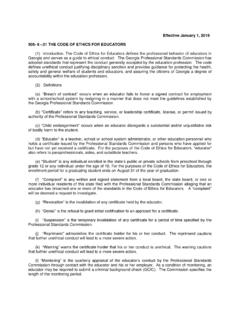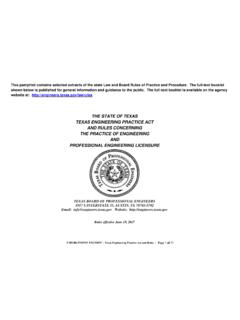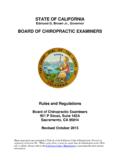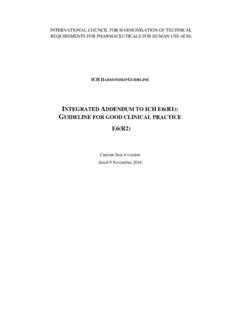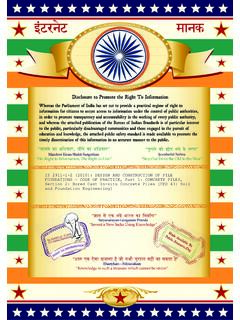Transcription of PACE Code D - GOV.UK
1 The code contained in this booklet has been issued by the Home Secretary under the Police and Criminal Evidence Act 1984 and has been approved by Parliament. Copies of the Codes issued under the Police and Criminal Evidence Act 1984 D. must be readily available in all police stations for consultation by police offcers, detained people and members of the public. code D. Revised code of practice for the identifcation of persons by Police Offcers code D. D e od C. 58446 PACE code D A5 1 09/02/2017 15:23. Police and Criminal Evidence Act 1984 (PACE). code D. Revised code of practice for the identification of persons by Police Officers February 2017. London: TSO. Published by TSO (The Stationery Offce) and available from: Online Mail, Telephone, Fax & E-mail TSO. PO Box 29, Norwich, NR3 1GN. Telephone orders/General enquiries: 0333 202 5070. Fax orders: 0333 202 5080. E-mail: Textphone 0333 202 5077. TSO@Blackwell and other Accredited Agents Published with the permission of the Home Offce on behalf of the Controller of Her Majesty's Stationery Offce.
2 Crown Copyright 2017. All rights reserved. You may re-use this document/publication (not including logos) free of charge in any format or medium, under the terms of the Open Government Licence To view this licence, visit or write to the Information Policy Team, The National Archives, Kew, Richmond, Surrey TW9 4DU;. or email: Where we have identifed any third party copyright information you will need to obtain permission from the copyright holders concerned. ISBN 978 0 11 341403 1. Printed on paper containing 75% recycled fbre content minimum Printed in the UK by the Williams Lea Group on behalf of the Controller of Her Majesty's Stationery Offce P002858632 C5 02/17 58446. POLICE AND CRIMINAL EVIDENCE ACT 1984. D. code D. REVISED. code of practice FOR THE IDENTIFICATION OF PERSONS. BY POLICE OFFICERS. Commencement - Transitional Arrangements This code has effect in relation to any identification procedure carried out after 00:00.
3 On 23 February 2017. 1. D. Codes of practice code D Identification of persons by police officers Contents 1 Introduction .. 4. Note for Guidance .. 5. 2 5. Notes for guidance .. 8. 3 Identification and recognition of 10. Part (A) Identification of a suspect by an eye-witness .. 10. (a) Cases when the suspect's identity is not known .. 10. (b) Cases when the suspect is known and available .. 11. Arranging eye-witness identification procedures duties of identification 12. Circumstances in which an eye-witness identification procedure must be held .. 13. Selecting an eye-witness identification 13. Notice to 14. (c) Cases when the suspect is known but not available .. 15. (d) Documentation .. 15. (e) Not used .. 16. (f) Destruction and retention of photographs taken or used in eye-witness identification procedures .. 16. Part (B) Recognition by controlled showing of films, photographs and images .. 16. Part (C) Recognition by uncontrolled viewing of films, photographs and images.
4 18. Notes for guidance .. 18. 4 Identification by fingerprints and footwear impressions .. 20. (A) Taking fingerprints in connection with a criminal investigation .. 20. (a) 20. (b) Action ..20. (c) Documentation .. 23. (B) Not 23. (C) Taking footwear impressions in connection with a criminal investigation .. 23. (a) Action ..23. (b) Documentation .. 24. Notes for guidance .. 24. 5 Examinations to establish identity and the taking of photographs .. 26. (A) Detainees at police stations .. 26. (a) Searching or examination of detainees at police stations .. 26. (b) Photographing detainees at police stations and other persons elsewhere than at a police station .. 27. (c) Information to be given .. 28. (d) Documentation .. 28. (B) Persons at police stations not detained .. 28. Notes for guidance .. 29. 6 Identification by body samples and impressions .. 31. (A) General .. 31. (B) Action .. 31. (a) Intimate samples .. 31. (b) Non-intimate samples.
5 32. (c) Removal of clothing .. 35. (c) Documentation .. 35. Notes for guidance .. 35. 2. D. Codes of practice code D Identification of persons by police officers ANNEX A VIDEO IDENTIFICATION .. 37. (a) General .. 37. (b) Conducting the video identification .. 38. (c) Image security and destruction .. 39. (d) Note for guidance .. 39. ANNEX B IDENTIFICATION PARADES .. 40. (a) General .. 40. (b) Identification parades involving prison inmates .. 40. (c) Conduct of the identification parade .. 40. (d) ANNEX C GROUP IDENTIFICATION .. 43. (a) General .. 43. (b) Identification with the consent of the suspect .. 44. Moving group ..44. Stationary groups ..44. All 45. (c) Group Identification without the suspect's consent .. 45. (d) Identifications in police stations .. 45. (e) Identifications involving prison 46. (f) ANNEX D CONFRONTATION BY AN EYE-WITNESS .. 47. ANNEX E SHOWING PHOTOGRAPHS TO EYE-WITNESSES .. 48. (a) Action .. 48.
6 (b) ANNEX F FINGERPRINTS, SAMPLES AND FOOTWEAR IMPRESSIONS . DESTRUCTION AND SPECULATIVE SEARCHES .. 49. Part A: Fingerprints and samples .. 49. DNA samples ..49. DNA profiles and fingerprints .. 49. Retention Periods: Fingerprints and DNA profiles .. 49. Table Retention periods .. 49. Speculative searches .. 50. Extensions of retention period .. 50. Part B: Footwear impressions .. 51. Part C: Fingerprints, samples and footwear impressions taken in connection with a criminal investigation from a person not suspected of committing the offence under investigation for elimination purposes.. 51. Notes for guidance .. 52. ANNEX G REQUIREMENT FOR A PERSON TO ATTEND A POLICE STATION FOR. FINGERPRINTS AND SAMPLES (PARAGRAPHS , AND ).. 53. Notes for guidance .. 53. 3. D. Codes of practice code D Identification of persons by police officers 1 Introduction This code of practice concerns the principal methods used by police to identify people in connection with the investigation of offences and the keeping of accurate and reliable criminal records.
7 The powers and procedures in this code must be used fairly, responsibly, with respect for the people to whom they apply and without unlawful discrimination. Under the Equality Act 2010, section 149 (Public sector Equality Duty), police forces must, in carrying out their functions, have due regard to the need to eliminate unlawful discrimination, harassment, victimisation and any other conduct which is prohibited by that Act, to advance equality of opportunity between people who share a relevant protected characteristic and people who do not share it, and to foster good relations between those persons. The Equality Act also makes it unlawful for police officers to discriminate against, harass or victimise any person on the grounds of the protected characteristics' of age, disability, gender reassignment, race, religion or belief, sex and sexual orientation, marriage and civil partnership, pregnancy and maternity when using their powers.
8 See Note 1A. In this code , identification by an eye-witness arises when a witness who has seen the offender committing the crime and is given an opportunity to identify a person suspected of involvement in the offence in a video identification, identification parade or similar procedure. These eye-witness identification procedures which are in Part A of section 3. below, are designed to: test the eye-witness' ability to identify the suspect as the person they saw on a previous occasion provide safeguards against mistaken identification. While this code concentrates on visual identification procedures, it does not prevent the police making use of aural identification procedures such as a voice identification parade , where they judge that appropriate. See Note 1B. In this code , separate provisions in Part B of section 3 below, apply when any person, including a police officer, is asked if they recognise anyone they see in an image as being someone who is known to them and to test their claim that they recognise that person.
9 These separate provisions are not subject to the eye-witnesses identification procedures described in paragraph Part C applies when a film, photograph or image relating to the offence or any description of the suspect is broadcast or published in any national or local media or on any social networking site or on any local or national police communication systems. Identification by fingerprints applies when a person's fingerprints are taken to: compare with fingerprints found at the scene of a crime check and prove convictions help to ascertain a person's identity. Identification using footwear impressions applies when a person's footwear impressions are taken to compare with impressions found at the scene of a crime. Identification by body samples and impressions includes taking samples such as a cheek swab, hair or blood to generate a DNA profile for comparison with material obtained from the scene of a crime, or a victim.
10 Taking photographs of arrested people applies to recording and checking identity and locating and tracing persons who: are wanted for offences fail to answer their bail. 4. D. Codes of practice code D Identification of persons by police officers Another method of identification involves searching and examining detained suspects to find, , marks such as tattoos or scars which may help establish their identity or whether they have been involved in committing an offence. The provisions of the Police and Criminal Evidence Act 1984 (PACE) and this code are designed to make sure fingerprints, samples, impressions and photographs are taken, used and retained, and identification procedures carried out, only when justified and necessary for preventing, detecting or investigating crime. If these provisions are not observed, the application of the relevant procedures in particular cases may be open to question. The provisions of this code do not authorise, or otherwise permit, fingerprints or samples to be taken from a person detained solely for the purposes of assessment under section 136.










